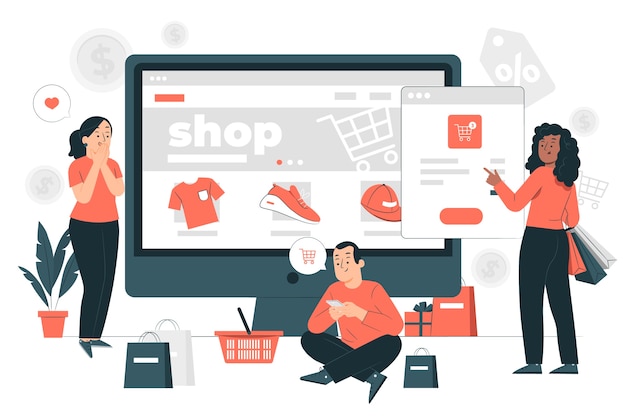What is Re-Commerce and Why Should You Pay Attention?

Photo by vectorjuice @ freepik
In an era of increasing economic uncertainty and environmental transparency, re-commerce is a trend which is significantly impacting retail and online purchasing.
The evolving re-commerce (reverse commerce) space is breathing new life into the sale and repurposing of pre-owned goods and challenging traditional consumption behaviours. Leaders industry-wide may not realise how this trend affects them; the implications of this growing phenomenon and its potential impact on B2C and B2B strategies could be profound.
What is re-commerce?
Re-commerce refers to the practice of buying, trading, and selling previously owned products. The concept of secondhand markets is nothing new to business leaders, but post-pandemic digitisation has amplified this trend. Meanwhile, the intensified spotlighting of environmental issues and sustainability has only increased awareness of the benefits of repurposing products.

In turn, we have ended up with a sophisticated and thriving ecosystem that extends far beyond traditional flea markets, thrift stores and eBay.
The re-commerce economic model encompasses:
- Reselling used products through online marketplaces
- Trade-in programs offered by retailers and manufacturers
- Refurbishing, repairing and upcycling initiatives
- Rental and subscription services for pre-owned items
This economic model has been touted as pivotal towards creating a more circular economy, where the extension of product life cycles, the reduction of waste and e-waste, and making products more accessible and affordable to more consumers are all championed. From selling and trading used cameras through sustainability-minded retailers like MPB to auctioning used cars and vehicles through Copart, and thousands of others, the re-commerce market is booming, where growing numbers of consumers are turning to these marketplaces.
As more shoppers embrace sustainable choices, many are opting to buy preloved fashion and clothing instead of new, further fuelling the expansion of these platforms.
As such, business leaders are taking notice.
This may interest you: How Leaders can champion Sustainability through Collective Action
What has caused the rise of re-commerce?
Several factors have contributed to the rapid growth of the re-commerce market:
- Younger generations, particularly Millennials and Gen Z, are increasingly adopting sustainable consumption patterns, and prefer to buy pre-owned items to preserve their budgets and reduce their environmental impact.
- The re-commerce market offers economic opportunities for both consumers and businesses to save money on purchases and generate income for the sale of unused items. In turbulent economic times, this has proven highly effective.
- Businesses are under growing pressure to reduce their environmental contributions, hence why many have incorporated re-commerce into their sustainability strategies, and explored more circular business models.
The business case for re-commerce
With pressure mounting on businesses and forward-thinking leaders, there is a financial and competitive incentive for them to adopt similar practices that align with re-commerce. While not exempt from scrutiny and obstacles, the benefits can be well worth such an investment.

Embracing re-commerce can open up new revenue streams. If organisations can offer trade-in programs or facilities for selling refurbished items, they can tap into a blossoming market that encourages eco- and price-conscious consumers to participate. In the long run, programs that facilitate the return or trade-in of used products can foster improved customer loyalty to brands. If an organisation can provide an incentive for customers to use their platforms when upgrading or replacing products, it will only increase customer satisfaction.
Re-commerce initiatives can uncover valuable, actionable data on product life cycles, usage patterns, and customer preferences. This information can be used to inform decisions on new product development and marketing strategies, as well as inventory management. Furthermore, as sustainability and price continue to be high on consumers’ priority lists when perusing products to buy, companies that embrace re-commerce can set themselves apart from competitors in the marketplace and stay one step ahead.
Despite these advantages, there are several challenges to be mindful of in the adoption of re-commerce.
Read more: Thoughtful Consumption: The “Last Mile” in Well-Being and Sustainability
Challenges to manage
Pre-owned items must be given ample quality control and validation, particularly when they are high-value or luxury items. Implementing strong inspection and verification processes and criteria will be essential in this regard. Furthermore, depending on the influx of pre-owned items and the outgoing of ones in stock, stricter and more efficient logistics and inventory management processes will need to be enforced. Organisations may need to invest in new infrastructure or partner with specialised third-party providers, to begin with before adopting it in-house.
Some organisations may (rightfully) worry that offering pre-owned product upcycling options could affect sales of new products. However, it may be reassuring to learn that research suggests re-commerce attracts a vastly different customer segment that is unaffected by those already scouring for new products.
Finally, over time, the re-commerce market may encounter more regulatory red tape, which means that businesses must stay abreast of new and evolving regulations regarding secondhand product sales.
The future of re-commerce
Looking ahead, the re-commerce sector is poised to grow even bigger, with emerging technologies like IoT and advanced predictive analytics likely to further enhance the efficiency and integration of such models. The re-commerce space (as of 2023) represents a $73 billion market and is projected to grow 10 times faster by 2030, ultimately reaching a $700 billion valuation.

Circular economy principles will continue to gain traction, where increased collaboration across supply chains will likely become more integrated and seamless.
For business leaders, re-commerce represents a fervent talking point when evaluating product value, consumer behaviour and brand loyalty. Embracing, rather than fighting, this trend will help them position their organisations at the forefront of a more circular and sustainable market. Paying close attention to this sector and understanding its implications will help you navigate it carefully while finding opportunities for innovation and growth.
Leaderonomics.com is an advertisement-free website. Your continuous support and trust in us allow us to curate, deliver and upkeep the maintenance of our website. When you support us, you enable millions to continue reading for free on our website. Will you give it today? Click here to support us.
Business
Tags: Abundance Mindset, Alignment & Clarity, Building Functional Competencies, Business Management





